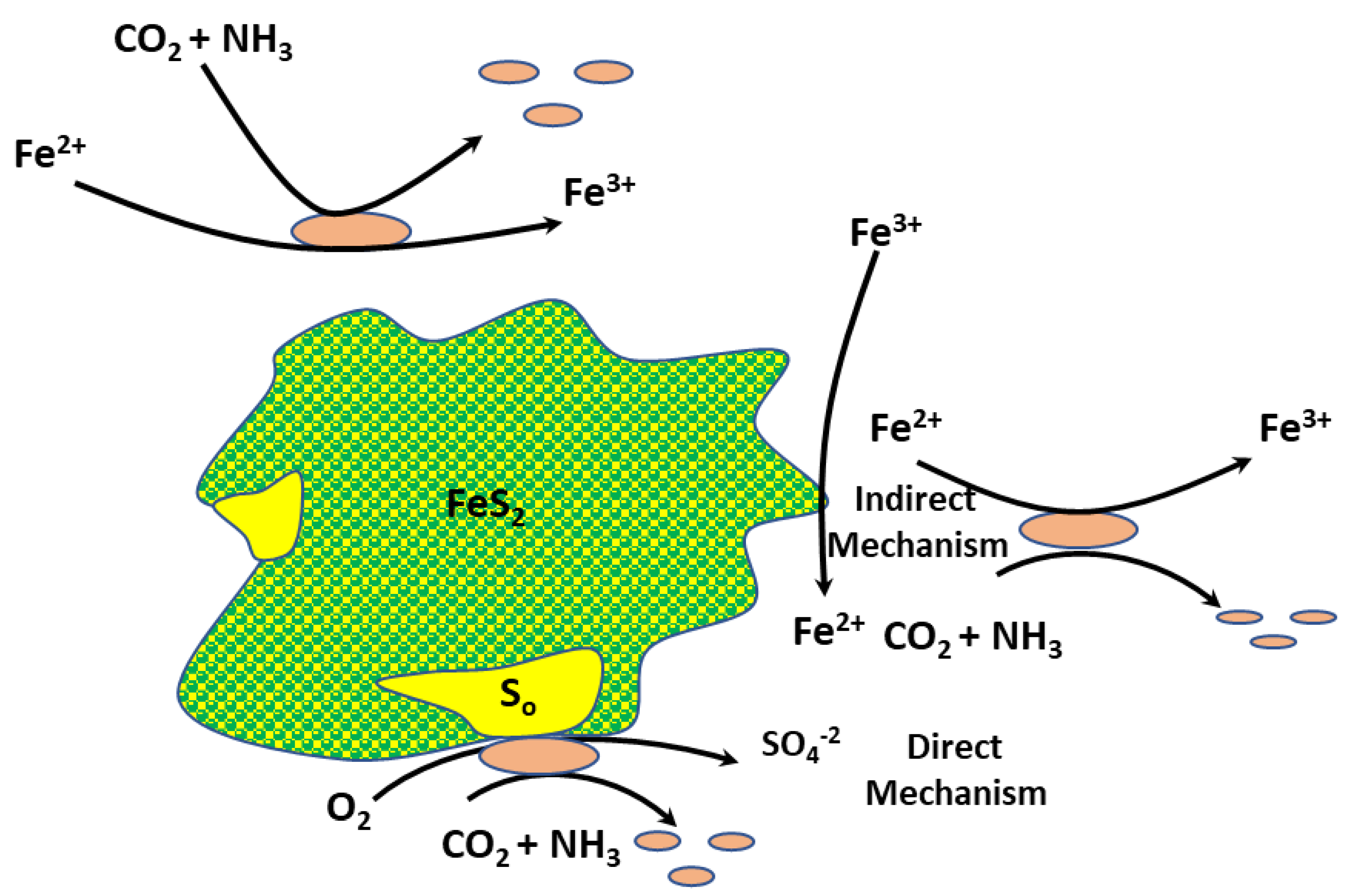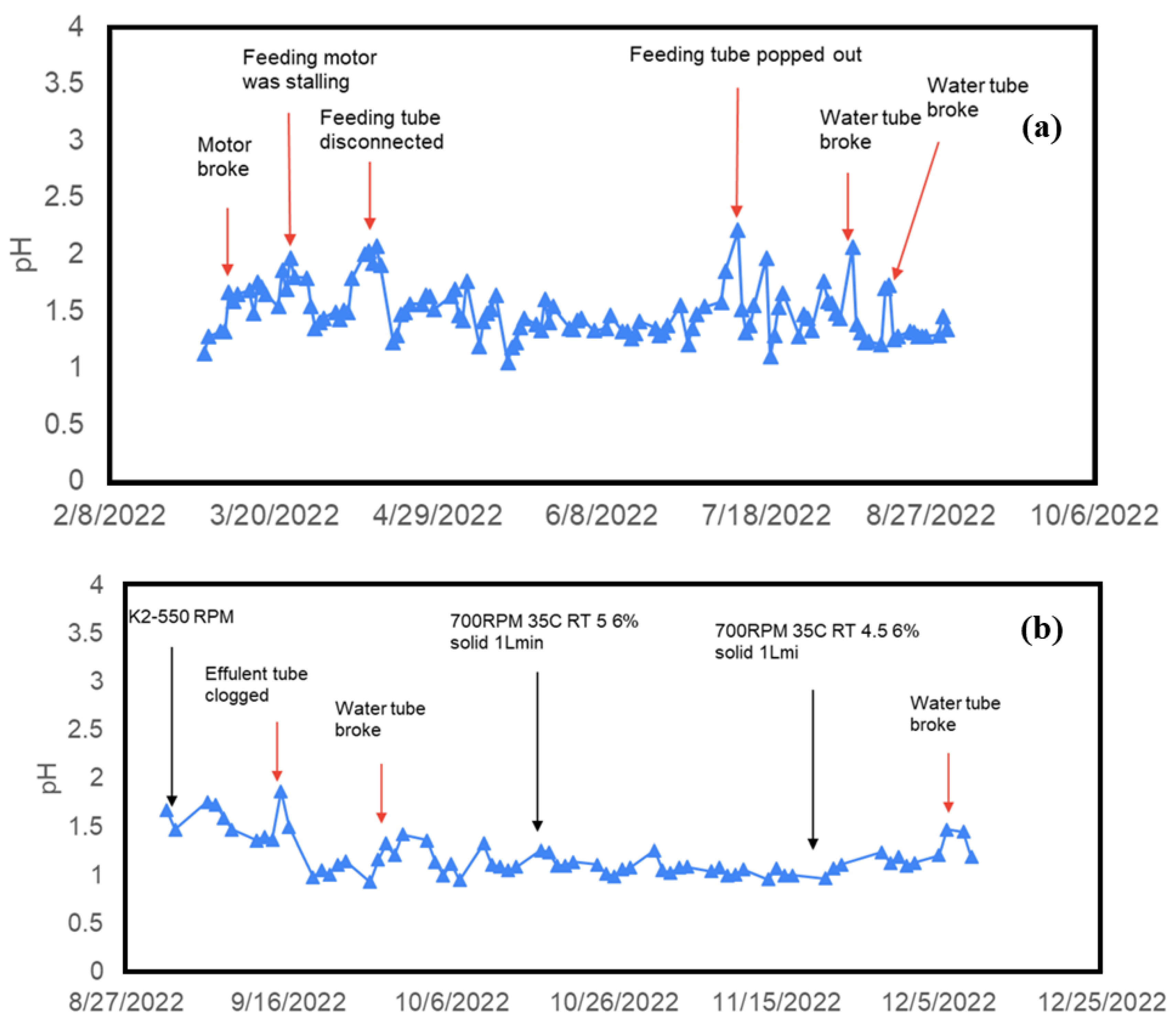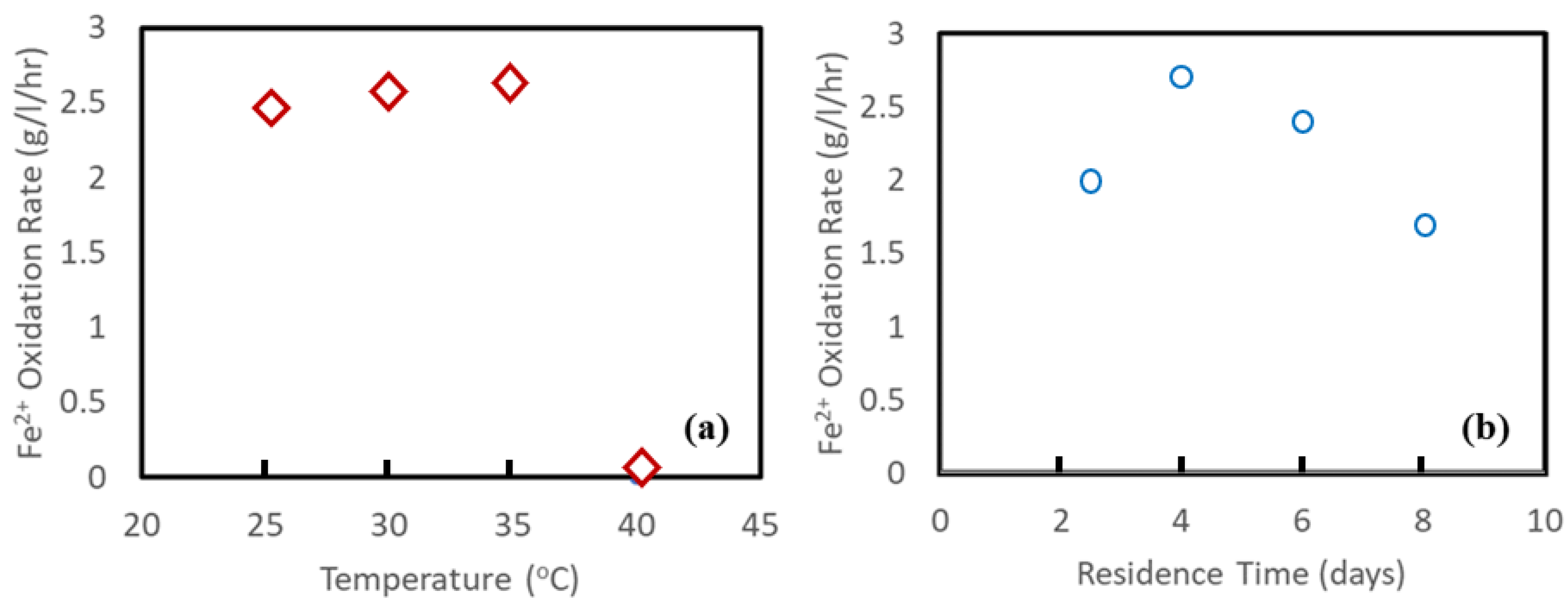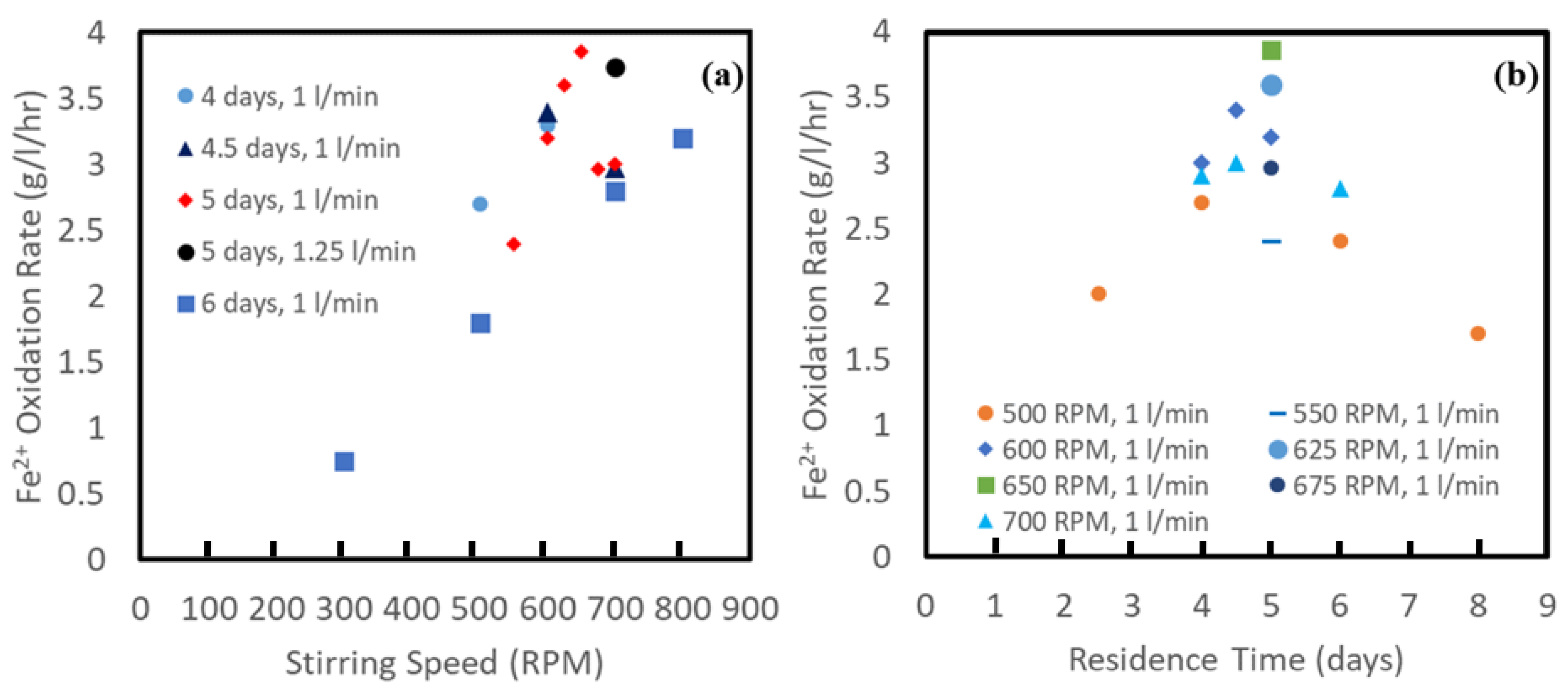Assessing and Improving Biooxidation for Acid Generation and Rare Earth Element Extraction
Abstract
1. Introduction
2. Experimental Procedures
2.1. Size Distribution Analysis
2.2. SEM Imaging and EDS Mapping Technique
2.3. XRD Analysis Procedure
2.4. ICP-MS Analysis Information
2.5. Acid Consumption Titration Procedure
2.6. Eh, and pH Measurements
2.7. Bio Reactor Experimental Setup
2.8. Feeding Solution Making and Flow Rate Setup Procedure
2.9. Ferrous Oxidation Rate Test
2.10. Acid Generation Rate Tracking Procedure
3. Results and Discussion
3.1. Feed Material Analysis
3.2. Biooxidation Rates and Data Analysis
- (NH4)2SO4: 6.0 g/L
- KCl: 0.2 g/L
- K2HPO4: 1 g/L
- MgSO4.7H2O: 1 g/L
- Ca(NO3)2: 0.02 g/L
3.3. Analysis of Bacteria
3.4. Assessment of Leaching of REE/CM from Pyrite Concentrate
4. Conclusions
Supplementary Materials
Author Contributions
Funding
Data Availability Statement
Acknowledgments
Conflicts of Interest
References
- Vera, M.; Schippers, A.; Sand, W. Progress in bioleaching: Fundamentals and mechanisms of bacterial metal sulfide oxidation—Part A. Appl. Microbiol. Biotechnol. 2013, 97, 7529–7541. [Google Scholar] [CrossRef]
- Rawlings, D.E. Heavy metal mining using microbes. Annu. Rev. Microbiol. 2002, 56, 65–91. [Google Scholar] [CrossRef]
- Rawlings, D.E.; Dew, D.; du Plessis, C. Biomineralization of metal-containing ores and concentrates. TRENDS Biotechnol. 2003, 21, 38–44. [Google Scholar] [CrossRef]
- Olson, G.; Brierley, J.; Brierley, C. Bioleaching review part B. Appl. Microbiol. Biotechnol. 2003, 63, 249–257. [Google Scholar] [CrossRef] [PubMed]
- Brierley, J.A. A perspective on developments in biohydrometallurgy. Hydrometallurgy 2008, 94, 2–7. [Google Scholar] [CrossRef]
- Johnson, D.B. Development and application of biotechnologies in the metal mining industry. Environ. Sci. Pollut. Res. 2013, 20, 7768–7776. [Google Scholar] [CrossRef]
- Brierley, C.L.; Le Roux, N.W. Bacterial leaching. CRC Crit. Rev. Microbiol. 1978, 6, 207–262. [Google Scholar] [CrossRef] [PubMed]
- Colmer, A.R.; Hinkle, M. The role of microorganisms in acid mine drainage: A preliminary report. Science 1947, 106, 253–256. [Google Scholar] [CrossRef]
- Valdés, J.; Pedroso, I.; Quatrini, R.; Dodson, R.J.; Tettelin, H.; Blake, R.; Eisen, J.A.; Holmes, D.S. Acidithiobacillus ferrooxidans metabolism: From genome sequence to industrial applications. BMC Genom. 2008, 9, 597. [Google Scholar] [CrossRef]
- Van Aswegen, P.; Godfrey, M.; Miller, D.; Haines, A. Developments and innovations in bacterial oxidation of refractory ores. Min. Metall. Explor. 1991, 8, 188–191. [Google Scholar] [CrossRef]
- Yang, Y.; Qian, C.; Shi, X.; Tian, B.; Chu, H.; Wang, J.; Xin, B. Efficient and industrial production of H2SO4 from sulfur sludge by acidophilic cells in a membrane bioreactor via optimizing process. J. Clean. Prod. 2020, 250, 119444. [Google Scholar] [CrossRef]
- Sarswat, P.K.; Podder, P.; Zhang, Z.; Free, M.L. Autogenous acid production using a regulated bio-oxidation method for economical recovery of REEs and critical metals from coal-based resources. Appl. Surf. Sci. Adv. 2022, 11, 100283. [Google Scholar] [CrossRef]
- Sarswat, P.K.; Leake, M.; Allen, L.; Free, M.L.; Hu, X.; Kim, D.; Noble, A.; Luttrell, G.H. Efficient recovery of rare earth elements from coal based resources: A bioleaching approach. Mater. Today Chem. 2020, 16, 100246. [Google Scholar] [CrossRef]
- Bailey, J.; Ollis, D. Applied enzyme catalysis. Biochem. Eng. Fundam. 1986, 2, 157–227. [Google Scholar]
- Podder, P.; Free, M.L.; Sarswat, P.K. Extraction and Recovery of Rare-Earth Elements and Critical Materials from Coal Waste Using Low Cost Processing Methods: Acid Generation Using Acidithiobacillus Ferrooxidans Mediated Bio-Oxidation of Pyrite. In Rare Metal Technology; Ouchi, T., Azimi, G., Forsberg, K., Kim, H., Alam, S., Neelameggham, N.R., Baba, A.A., Peng, H., Eds.; Springer International Publishing: Cham, Switzerland, 2022; pp. 51–62. [Google Scholar]
- Podder, P.; Zhang, Z.; Honaker, R.Q.; Free, M.L.; Sarswat, P.K. Evaluating and Enhancing Iron Removal via Filterable Iron Precipitates Formation during Coal-Waste Bioleaching. Eng 2021, 2, 632–642. [Google Scholar] [CrossRef]
- Zhang, Z.; Allen, L.; Podder, P.; Free, M.L.; Sarswat, P.K. Recovery and Enhanced Upgrading of Rare Earth Elements from Coal-Based Resources: Bioleaching and Precipitation. Minerals 2021, 11, 484. [Google Scholar] [CrossRef]
- Murali, A.; Plummer, M.J.; Shine, A.E.; Free, M.L.; Sarswat, P.K. Optimized bioengineered copper recovery from electronic wastes to increase recycling and reduce environmental impact. J. Hazard. Mater. Adv. 2022, 5, 100031. [Google Scholar] [CrossRef]
- Haghshenas, D.F.; Alamdari, E.K.; Torkmahalleh, M.A.; Bonakdarpour, B.; Nasernejad, B. Adaptation of Acidithiobacillus ferrooxidans to high grade sphalerite concentrate. Miner. Eng. 2009, 22, 1299–1306. [Google Scholar] [CrossRef]
- Rawlings, D.E.; Johnson, D.B. The microbiology of biomining: Development and optimization of mineral-oxidizing microbial consortia. Microbiology 2007, 153, 315–324. [Google Scholar] [CrossRef]
- Johnson, D.B. Biomining—Biotechnologies for extracting and recovering metals from ores and waste materials. Curr. Opin. Biotechnol. 2014, 30, 24–31. [Google Scholar] [CrossRef]
- Zhang, X.; Liu, X.; Yang, F.; Chen, L. Pan-Genome Analysis Links the Hereditary Variation of Leptospirillum ferriphilum With Its Evolutionary Adaptation. Front. Microbiol. 2018, 9, 577. [Google Scholar] [CrossRef] [PubMed]










| Element | Feed (ppm) | Extraction (%) |
|---|---|---|
| Al | 1383 | 14.71 |
| Co | 32.86 | 76.11 |
| Dy | 1.91 | 41.36 |
| Er | 0.98 | 56.12 |
| Gd | 6.65 | 20.75 |
| Ho | 0.3 | 56.67 |
| Lu | 0.14 | 50.00 |
| Mg | 1991 | 30.84 |
| Sc | 3.86 | 47.67 |
| Tb | 0.31 | 38.71 |
| Tm | 0.09 | 55.56 |
| Y | 7.31 | 53.63 |
| Yb | 1.94 | 30.41 |
| Zn | 1482 | 11.76 |
Disclaimer/Publisher’s Note: The statements, opinions and data contained in all publications are solely those of the individual author(s) and contributor(s) and not of MDPI and/or the editor(s). MDPI and/or the editor(s) disclaim responsibility for any injury to people or property resulting from any ideas, methods, instructions or products referred to in the content. |
© 2023 by the authors. Licensee MDPI, Basel, Switzerland. This article is an open access article distributed under the terms and conditions of the Creative Commons Attribution (CC BY) license (https://creativecommons.org/licenses/by/4.0/).
Share and Cite
Free, M.L.; Ilunga, J.K.; Podder, P.; Sarswat, P.K. Assessing and Improving Biooxidation for Acid Generation and Rare Earth Element Extraction. Processes 2023, 11, 1005. https://doi.org/10.3390/pr11041005
Free ML, Ilunga JK, Podder P, Sarswat PK. Assessing and Improving Biooxidation for Acid Generation and Rare Earth Element Extraction. Processes. 2023; 11(4):1005. https://doi.org/10.3390/pr11041005
Chicago/Turabian StyleFree, Michael L., Joel K. Ilunga, Prasenjit Podder, and Prashant K. Sarswat. 2023. "Assessing and Improving Biooxidation for Acid Generation and Rare Earth Element Extraction" Processes 11, no. 4: 1005. https://doi.org/10.3390/pr11041005
APA StyleFree, M. L., Ilunga, J. K., Podder, P., & Sarswat, P. K. (2023). Assessing and Improving Biooxidation for Acid Generation and Rare Earth Element Extraction. Processes, 11(4), 1005. https://doi.org/10.3390/pr11041005








